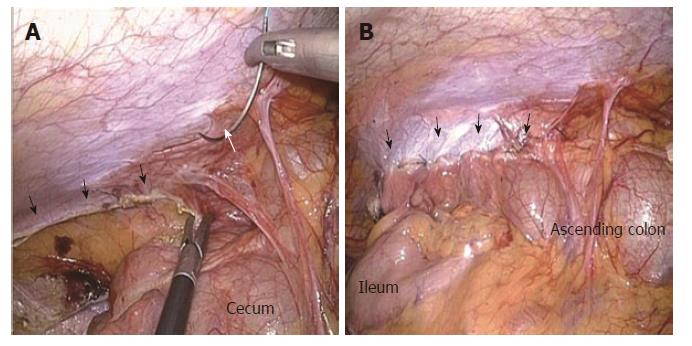Copyright
©The Author(s) 2017.
World J Gastroenterol. Sep 21, 2017; 23(35): 6534-6539
Published online Sep 21, 2017. doi: 10.3748/wjg.v23.i35.6534
Published online Sep 21, 2017. doi: 10.3748/wjg.v23.i35.6534
Figure 1 Target sign on abdominal ultrasonography (A) and contrast-enhanced computed tomography scan (B).
The so-called bowel-within-bowel configuration, in which the layers of the bowel are duplicated, thereby forming concentric rings, is seen (white arrows). Dilatation of the terminal ileum is observed (black arrows). C: A colonoscopic view of the intussusception. Edematous colonic mucosa was identified on the lead point of intussusception. No neoplastic lesion was detected, even after reduction of intussusception.
Figure 2 Laparoscopic view.
A: A linear indentation leaving a trace of intussusception was found in the middle portion of the ascending colon (white arrows). The cecum was not attached to the retroperitoneum (black arrows); B: The cecum was easily moved to the upper abdomen. No fixation of the cecum was observed (black arrows).
Figure 3 Laparoscopic cecopexy.
A: An approximately 10-cm long incision (black arrows) was made on the right parietal peritoneum along the ascending colon; B: The cecum and ascending colon were stitched to the parietal peritoneum with continuous sutures using an absorbable barbed wound suture device (black arrows).
- Citation: Yamamoto T, Tajima Y, Hyakudomi R, Hirayama T, Taniura T, Ishitobi K, Hirahara N. Case of colonic intussusception secondary to mobile cecum syndrome repaired by laparoscopic cecopexy using a barbed wound suture device. World J Gastroenterol 2017; 23(35): 6534-6539
- URL: https://www.wjgnet.com/1007-9327/full/v23/i35/6534.htm
- DOI: https://dx.doi.org/10.3748/wjg.v23.i35.6534











